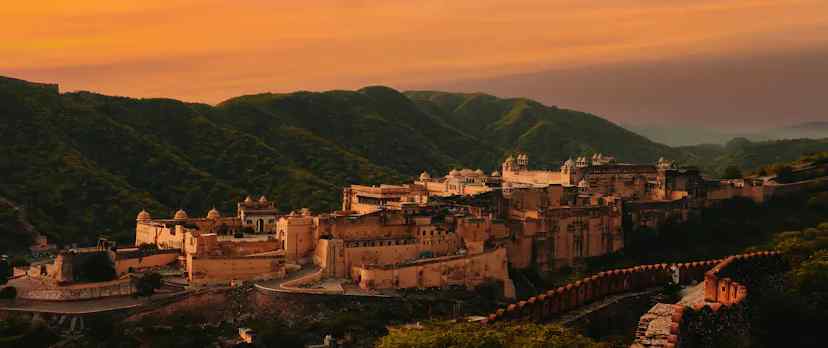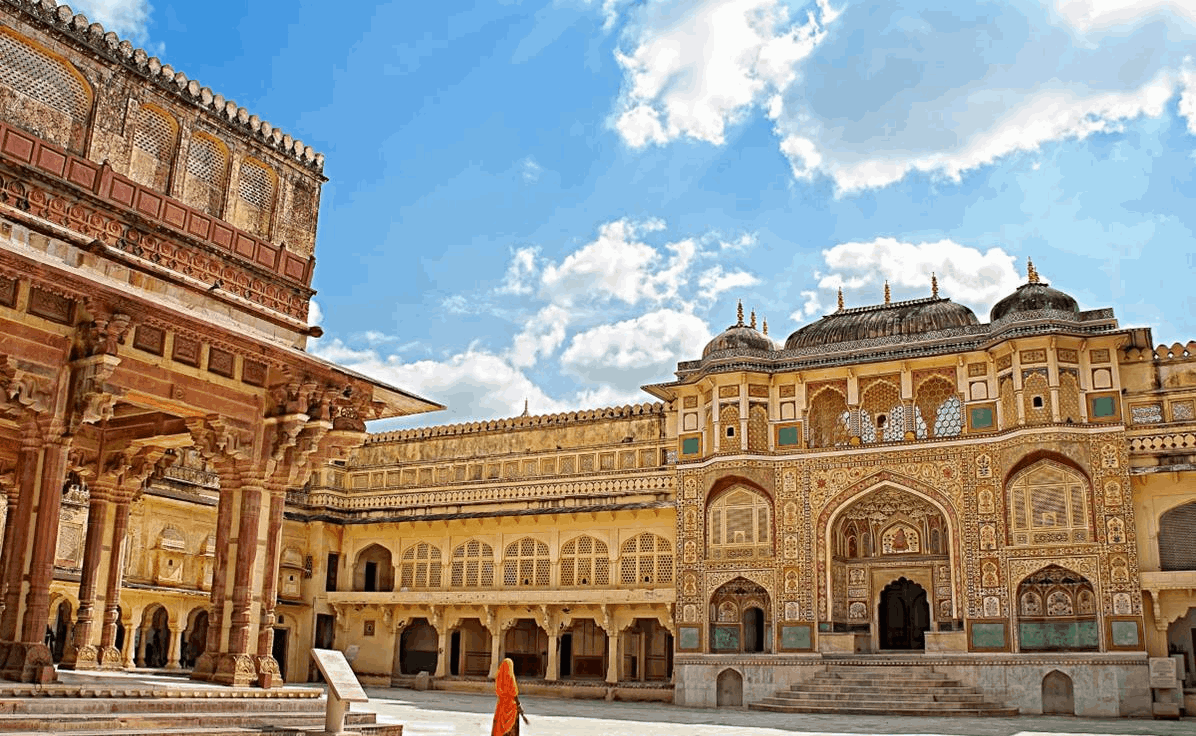Nestled amidst the rugged Aravalli hills of Rajasthan, the Amber Palace stands as a magnificent testament to India’s rich architectural and cultural heritage. This historic fort-palace complex, located in the town of Amer, near Jaipur, is renowned for its grandeur, intricate design, and historical significance. This article delves into the history, architecture, cultural impact, and contemporary relevance of Amber Palace, offering a comprehensive exploration of one of India’s most iconic landmarks.
Historical Background
The Amber Palace, also known as Amer Fort, was constructed by Raja Man Singh I, the ruler of Amer, in the late 16th century. The construction began in 1592 and continued over several decades, with subsequent rulers adding their contributions. The palace served as the primary residence of the Rajput Maharajas of the Kachwaha dynasty until the capital was moved to Jaipur in 1727.
- Foundation and Construction: Raja Man Singh I, a trusted general in Emperor Akbar’s court, commissioned the construction of the palace. It was designed to reflect both Rajput and Mughal architectural styles, showcasing the harmonious blend of these two distinct traditions. The construction utilized locally available red sandstone and marble, creating a striking contrast that enhances the palace’s aesthetic appeal.
- Subsequent Additions: The palace underwent several modifications and expansions under subsequent rulers, including Maharaja Jai Singh II and Maharaja Sawai Jai Singh II. Each ruler contributed to the palace’s opulence, adding their unique touches and architectural innovations.

Architectural Splendor
The Amber Palace is celebrated for its exquisite architecture, characterized by a blend of Rajput, Mughal, and Persian influences. The complex is strategically situated on a hilltop, offering panoramic views of the surrounding landscape. The layout of the palace is meticulously planned, reflecting the grandeur and sophistication of Rajput architecture.
- The Main Courtyard: The palace is organized around a series of courtyards, with the main courtyard serving as the focal point. This open space, surrounded by grand structures, is adorned with decorative elements and provides a central area for ceremonial and administrative activities.
- The Sheesh Mahal: One of the most famous features of Amber Palace is the Sheesh Mahal (Mirror Palace). This hall is renowned for its intricate mirror work, which creates a dazzling effect when illuminated. The walls and ceilings of the Sheesh Mahal are adorned with tiny glass pieces, arranged to form elaborate patterns and designs.
- The Jai Mandir: The Jai Mandir (Hall of Victory) is another notable section of the palace. It is characterized by its elegant pillars, intricately carved ceilings, and ornate decorations. The Jai Mandir was used for royal functions and gatherings, reflecting the palace’s role as a center of governance and celebration.
- The Ganesh Pol: The Ganesh Pol (Ganesh Gate) is a beautifully decorated gateway leading to the private quarters of the palace. It is adorned with intricate carvings of Lord Ganesha, the elephant-headed deity, and serves as a symbolic entrance to the royal living quarters.
- The Sukh Niwas: The Sukh Niwas (Hall of Pleasure) is designed to offer a serene and cooling atmosphere. It features a unique water cooling system, where water channels and fountains create a refreshing environment. The Sukh Niwas is adorned with floral patterns and delicate frescoes, adding to its aesthetic appeal.

Cultural and Historical Significance
Amber Palace holds significant cultural and historical importance, not only for its architectural marvels but also for its role in the history of Rajasthan. It reflects the lifestyle, governance, and artistic achievements of the Rajput rulers.
- Rajput Heritage: The palace embodies the Rajput ethos of valor, honor, and grandeur. The Rajput rulers, known for their chivalry and strategic acumen, used the Amber Palace as a symbol of their power and influence. The palace’s design and decoration reflect the Rajput commitment to both artistic excellence and functional elegance.
- Mughal Influence: The Amber Palace’s architecture showcases a fusion of Rajput and Mughal styles. This blend is indicative of the political and cultural interactions between the Rajput states and the Mughal Empire. The Mughal influence is particularly evident in the palace’s ornate decorations, gardens, and water features.
- Royal Ceremonies: The palace was the site of numerous royal ceremonies, including coronations, marriages, and other state functions. The grandeur of the palace provided an appropriate backdrop for these important events, reinforcing its status as a center of power and prestige.
Preservation and Restoration
Over the centuries, the Amber Palace has faced various challenges, including natural wear and tear, neglect, and the impact of historical conflicts. However, efforts to preserve and restore the palace have been ongoing, ensuring its continued relevance and beauty.
- Restoration Efforts: The Archaeological Survey of India (ASI) and the Rajasthan State Archaeology Department have undertaken significant restoration projects to preserve the palace’s structural integrity and artistic elements. These efforts include repairing damaged sections, cleaning intricate carvings, and maintaining the palace’s overall appearance.
- Tourism and Conservation: The Amber Palace is a major tourist attraction, drawing visitors from around the world. Managing the balance between tourism and conservation is a key challenge, with efforts focused on minimizing the impact of visitor footfall while ensuring the palace’s preservation.

Cultural Impact
The Amber Palace has a profound cultural impact, influencing various forms of art, literature, and popular culture. Its depiction in films, books, and other media highlights its significance as a symbol of India’s rich heritage.
- Artistic Inspirations: The palace has inspired numerous artists, including painters, sculptors, and photographers. Its intricate designs and historical ambiance provide a rich source of inspiration for creative works.
- Film and Media: The Amber Palace has been featured in several Indian films and television series, showcasing its architectural splendor and historical significance. Its portrayal in media helps promote awareness and appreciation of Rajasthan’s cultural heritage.

Visitor Experience
Visiting the Amber Palace offers a unique opportunity to experience the grandeur of Rajput architecture and the historical richness of Rajasthan. The palace’s layout, gardens, and decorative elements provide a captivating experience for tourists.
- Guided Tours: Guided tours are available for visitors, providing insights into the palace’s history, architecture, and cultural significance. These tours enhance the visitor experience by offering a deeper understanding of the palace’s context and features.
- Cultural Events: The palace occasionally hosts cultural events, including traditional music and dance performances. These events offer visitors a chance to experience the cultural heritage of Rajasthan in a historic setting.
Conclusion
The Amber Palace stands as a majestic symbol of Rajasthan’s regal history and architectural brilliance. Its intricate design, historical significance, and cultural impact make it a remarkable landmark, reflecting the grandeur of the Rajput era. As efforts to preserve and protect this architectural gem continue, the Amber Palace remains a testament to India’s rich heritage and a source of inspiration for future generations.

I’ll definitely be sharing this. Thanks for all the hard work.
Thank You For Your Response Cricbuzz
Fantastic article! It answered so many of my questions.
Thank You For Your Response Onlyfans
I always find myself coming back to your posts.
What motivates you to keep creating content?
Thank You For Your Response Snapchat
You can certainly see your skills in the work you write.
The sector hopes for more passionate writers such as you who aren’t afraid to mention how they believe.
Always go after your heart.
Thank You For Your Response Anchor Emoji
Such a valuable post! It’s so thorough and easy to understand.
Much respect!
Thank You For Your Response http://www.speedtest.net
Loved the article! Do you think there are emerging tools that could further enhance this strategy?
Thank You For Your Response Binance
I appreciate this post! How would you modify this method for other fields?
Thank You For Your Response http://www.target.com